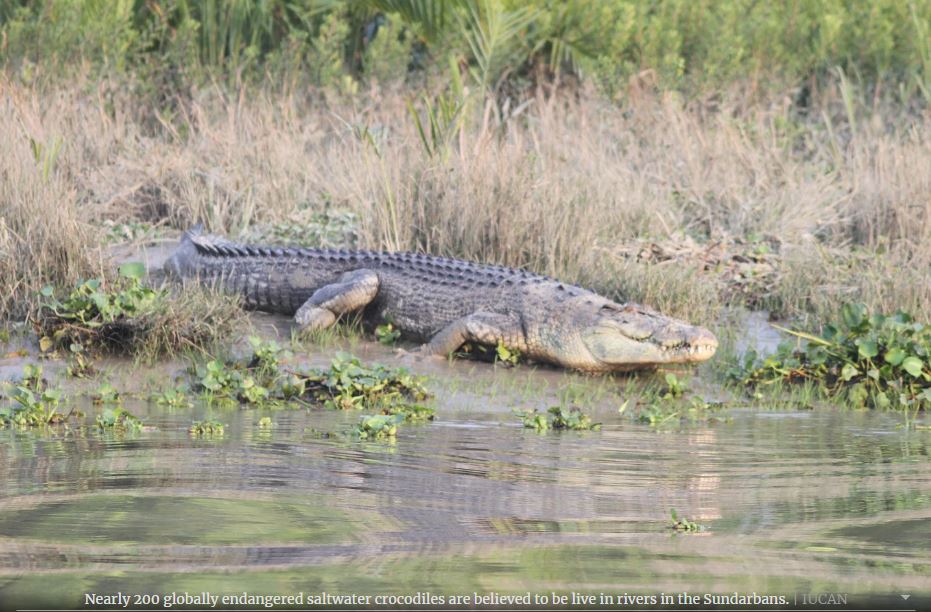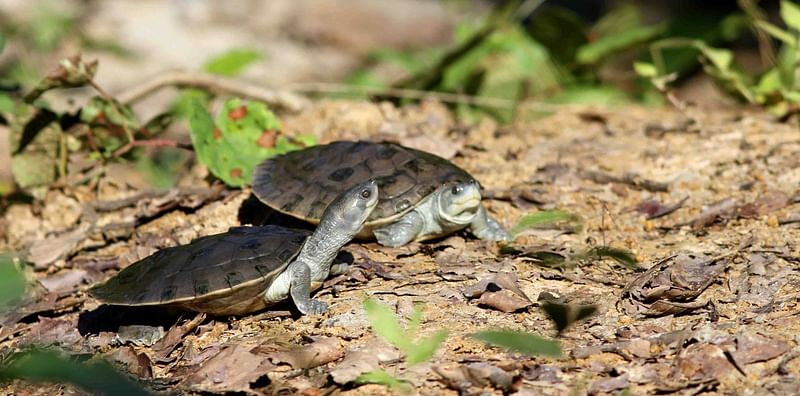World Wildlife Day: Wild animals no more safe in the wild

“Wild animals are safe in the wild, children in their mothers’ grasp” – it’s a widely known quote from the travelogue Palamou by Sanjib Chandra Chattopadhyay. The theme of this year’s World Wildlife Day reminds of it and the theme is "Forests and Livelihoods: Sustaining People and Planet."
On 20 December 2013, the United Nations, at its 68th session of the general assembly, proclaimed 3 March the World Wildlife Day. The day was also celebrated in Bangladesh on Wednesday. However, the main focus is environment and biodiversity must be protected for the sake of the existence of human being. In that perspective, learning about the state of the forest and the wildlife in Bangladesh is necessary.

Nearly 200 globally endangered saltwater crocodiles are believed to be live in rivers in the Sundarbans. IUCAN
The rate of biodiversity decline in Bangladesh is higher compared to the global situation. According to the Food and Agriculture Organization of the United Nations (FAO), 1.5 per cent of the world's forest area has shrunk to 2015 from 2000. On the contrary, 2.5 per cent of Bangladesh’s forest area has been destroyed during the same period. A report of World Wildlife Fund says the number of the wild animals has decreased by two-third globally since 1970. Three-fourth of land area and 40 per cent of biodiversity have been damaged severely in the past 50 years. As many as 31 species of animals have become extinct from Bangladesh in the past 100 years.
Environment-damaging ‘development’ work and change in biodiversity affect the wildlife. For example, rivers and canals are being filled up due to rise in dam, road, grabbing marshlands and commercial activities. Habitations of wildlife are being destroyed too. Wild animals are not safe in the protected areas too.

This 28 February photo shows a capped langur in Satchari National Park in Chunarughat upazila of Habiganj. Mosabber Hossain
According to the forest department, on an average, 50 animals are run over by vehicles every year in Lawachara National Park of Moulvibazar.
Besides, the construction of railway tracks from Dohajari to Cox’s Bazar on the movement routes of elephant in Chattogram is underway. The movement of elephants has stopped due to construction of railway tracks inside Chunati Wildlife Sanctuary in Lohagara.
International Union for Conservation of Nature (IUCAN) has listed 49 areas in 15 countries in its green list of protected and conserved areas. No area of Bangladesh has been listed yet.

The northern river terrapin (Batagur baska) is one of the critically endangered species globally. IUCAN
Bangladesh is used as the international transit route for poaching wild animals. According to media reports, wild animals and plants worth Tk 5 billion (500 crore) are smuggled via roadways, waterways and airways every year. Royal Bengal Tiger, pangolin and gecko face more risk of poaching. Killing and poaching didn’t stop despite the formation of Wildlife Crime Control Unit comprised of forest department, police, Rapid Action Billiton, Bangladesh Coast Guard and Border Guard Bangladesh. The 1973 Wildlife Act has been amended and the Wildlife (Conservation and Security) Act 2012 has been formulated in order to prevent the killing and poaching of wild animals in the country. Yet, development and commercial activities have been increasing in the protected area defying the law.

The coastal area of Bangladesh is the largest habitat of globally endangered Irwarrdy the Irrawaddy dolphin. IUCAN
As many as 41 protected areas have been declared in Bangladesh. Associate management system engaging local people has been introduced in 22 protected areas. Recently, ketoprofen has been banned to save the vultures from extinction. Concerted efforts among the government, the locals and different organisations like IUCAN has yielded positive results to save several spices including tigers, gharial, dolphin and vulture in the protected areas. If more initiatives can be taken, wild animals and biodiversity will be protected.
Deputy magistrate Sanjib Chandra Chattopadhyay during the colonial British rule had realised that a thing is valued where it belongs. Mothers’ grasp is important for the growth of children as much as healthy and safe forests are required for expansion and wellbeing of wild animals. If the state and the executive branch work responsibly realising this truth then wild animals will be safe in the wild and children in their mothers’ grasp.
* Rashed Al Mahmud Titumir is a professor at the Department of Development Studies, University of Dhaka, and the chairperson of IUCN Bangladesh – National Committee.

